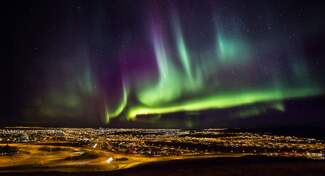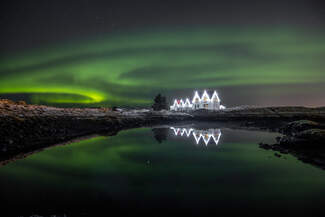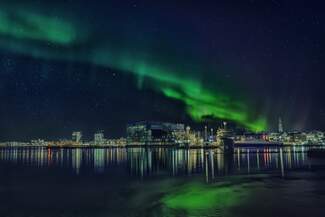How to Maximize Your Viewing Chances in Reykjavík
Even with increased solar activity, the right conditions help ensure a magical show:
Darkness: Best seen after sunset—especially between 9 PM and 2 AM
Clear Skies: Minimal cloud cover is key
Low Light Pollution: Head to areas like Grótta Lighthouse or Öskjuhlíð forest
Check daily conditions at icelandatnight.is
icelandatnight.is offers up-to-date aurora forecasts, real-time cloud cover maps, and viewing tips—perfect for planning your night out under the stars.
Myth Busted: You don’t need freezing temperatures to see the lights! That said, colder air can mean clearer skies.
Bonus: Keep an eye out for Glitský—rainbow-like polar stratospheric clouds that occasionally grace Reykjavík’s winter skies.
How to Photograph the Northern Lights
Want to capture the aurora magic on camera? Here are a few simple tips:
- Use a tripod: Even minor movements blur night shots.
- Manual mode: Adjust ISO (800–3200), aperture (f/2.8–f/4), and a longer shutter speed (5–20 seconds).
- Focus on infinity: Autofocus doesn’t work well in the dark—switch to manual.
- Use a wide-angle lens: To capture as much of the sky as possible.
- Don’t forget your phone! Newer models with Night Mode can also produce stunning shots—just keep your hand steady or rest your phone on a surface.
Get more tips on how to catch the perfect picture HERE.
A Once-in-a-Decade Opportunity
Reykjavík offers more than a glimpse of the aurora—it provides a truly personal and unforgettable connection with the natural world. There’s something powerful about seeing the Northern Lights from a vibrant, welcoming city where you can experience Icelandic culture and nature in harmony.
Whether you’re capturing every moment or just standing still under a glowing sky, the 2025–2026 aurora seasons promise unforgettable beauty—and Reykjavík is the perfect place to be.
Plan Your Aurora Adventure
Reykjavík offers something for every type of traveler—whether you're solo, with family, or on a romantic escape. Choose from:



